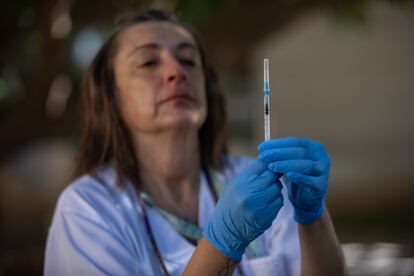Is it necessary for words to be vaccinated too?


Fewer and fewer words are accented. The accent mark is being lost in many of them, which brings to mind Ramón Gómez de la Serna's greguería, where he defined the accent as the vaccine of the word. Now that we're at it, we can only wonder where the word "vaccine" comes from .
To do so, we must go back to the 18th century with the help of the British writer Mary Wortley Montagu (1689-1762), who discovered the solution to eradicating smallpox. It was during a trip to Turkey in 1717 that she noticed how mothers inoculated their children with smallpox to protect them against a disease about which little or nothing was known. This prophylaxis technique is called variolation. In this way, seemingly magical—but scientifically rooted —secrets were revealed to Mary, whose letters from the other side of the world aroused the admiration of the intellectual elite of the time, as well as inspiring the Orientalist style of painters such as Ingres. The aforementioned letters have been compiled in Spanish by the publishing house La Línea del Horizonte under the title: Cartas desde Estambul .
For anyone who wishes to immerse themselves in the narrow streets of Istanbul, with its bazaars and mosques, as well as the Turkish baths and harems of the period, this is a highly recommended read. However, the most important scientific information lies in the remedy for smallpox, a disease that Mary Wortley Montagu had suffered from herself. But the most painful part for her was the loss of her brother to the disease.
The royal family, interested in variolation, funded an experimental study. The guinea pigs, in this case, were inmates at Newgate Prison who were inoculated with the virus in exchange for being released. The experiment was a success. But long before that, let's say centuries earlier, the Chinese had already applied the variolation technique by grinding up dried scabs from people with smallpox and then snorting the resulting powder. It wasn't that they weren't affected; what happened was that the smallpox they developed was mild and they survived, providing them with immunity for the rest of their lives .
As for Western inoculation, it was carried out on the arm, where a cut was made, into which the contents of a sick person's pustule were applied. But it wasn't until 1796 that the first modern vaccine was created thanks to the English physician Edward Jenner and Sarah Nelmes, the cow milker who appeared at his office with the typical signs of cowpox. Her clinical picture was compounded by a low-grade fever and constant headaches. It was then that Dr. Jenner put into practice something that had been on his mind for some time, applying the contents of Sarah Nelmes's pustule to an eight-year-old boy who had not yet suffered from the disease . And that's how it all began.
Because, at first, the boy suffered a mild reaction, and weeks later, the doctor inoculated him with smallpox again, but this time from a person who showed no reaction at all. Since immunity was achieved thanks to cows, the word "vaccine" was coined from them to describe the remedy. From then on—as Gómez de la Serna aptly pointed out in another of his greguerías—cows write the poem of resignation with the inkwell of their eyes.
The stone axe It is a section where Montero Glez , with a desire for prose, exercises his particular siege on scientific reality to demonstrate that science and art are complementary forms of knowledge.
EL PAÍS





